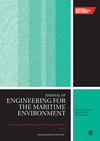The application of laminar numerical wave tank for a heaving buoy hydrodynamics study in low-turbulence nonlinear waves
IF 1.5
4区 工程技术
Q3 ENGINEERING, MARINE
Proceedings of the Institution of Mechanical Engineers, Part M: Journal of Engineering for the Maritime Environment
Pub Date : 2023-04-19
DOI:10.1177/14750902231168674
引用次数: 1
Abstract
Numerical Wave Tanks (NWTs) allow for in-depth investigations into the hydrodynamics and wave responses of floating objects. Thus, they are widely used during the design phase of many offshore platforms and devices. Such problems often feature low turbulence, with wave propagation and wave-object interaction being the key features. In this paper, the merits of using a laminar flow model for a NWT with a free-to-heave buoy, subject to second order Stokes waves in a low sea state is investigated. The simulations are implemented using the interFoam solver, which is embedded in OpenFOAM. The time series of waves measured upstream and downstream of the buoy, and the buoy hydrodynamics are compared to analytical and experimental results for accuracy evaluations. It is shown that, due to the low turbulence level of the problem, the laminar approach can deliver more accurate results than turbulent models, such as Reynolds-averaged Navier-Stokes Simulation (RANS) or partially-averaged Navier-Stokes Simulation (PANS). Moreover, the simulation time of the laminar simulations is significantly shorter than to those of RANS and PANS.层流数值波槽在低度湍流非线性波浪中升沉浮筒流体动力学研究中的应用
数值波槽(NWTs)允许深入研究流体力学和浮动物体的波浪响应。因此,它们在许多海上平台和设备的设计阶段被广泛使用。这类问题通常以低湍流度为特征,波的传播和波-物相互作用是关键特征。本文研究了低海况下二阶斯托克斯波作用下带自由升沉浮标的西北西北海域层流模型的优点。仿真是使用嵌入在OpenFOAM中的interFoam求解器实现的。将浮标上下游测得的波浪时间序列以及浮标的水动力与分析结果和实验结果进行了比较,以评价浮标的精度。结果表明,由于问题的湍流程度较低,层流方法比湍流模型(如reynolds -average Navier-Stokes Simulation (RANS)或部分平均Navier-Stokes Simulation (PANS))可以提供更准确的结果。层流模拟的模拟时间明显短于RANS和PANS的模拟时间。
本文章由计算机程序翻译,如有差异,请以英文原文为准。
求助全文
约1分钟内获得全文
求助全文
来源期刊

CiteScore
3.90
自引率
11.10%
发文量
77
审稿时长
>12 weeks
期刊介绍:
The Journal of Engineering for the Maritime Environment is concerned with the design, production and operation of engineering artefacts for the maritime environment. The journal straddles the traditional boundaries of naval architecture, marine engineering, offshore/ocean engineering, coastal engineering and port engineering.
 求助内容:
求助内容: 应助结果提醒方式:
应助结果提醒方式:


